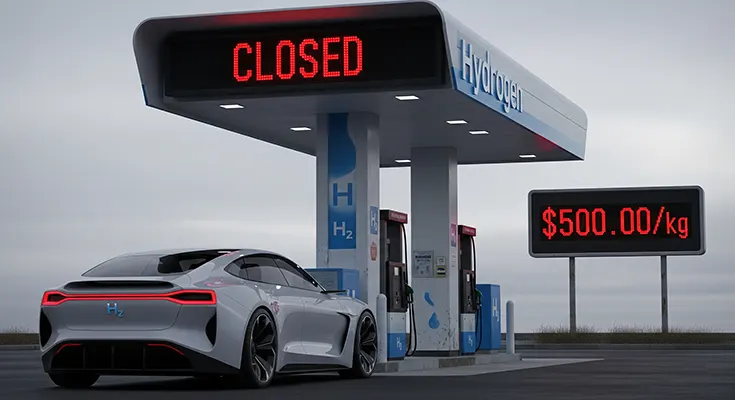Hydrogen fuel cell vehicles (FCEVs) offer a compelling zero-emission alternative to battery-electric vehicles (BEVs) and traditional gasoline cars. They promise quick refueling times and long ranges, mirroring the convenience of the conventional gas station model. However, a significant obstacle to their widespread adoption is the sparse and costly infrastructure required to support them. The limited availability and high cost of hydrogen fueling stations represent a classic “chicken and egg” problem, where a lack of cars discourages station development, and a lack of stations discourages car sales.
The Cost to Build: A Multi-Million Dollar Investment
Building a hydrogen fueling station is a complex and expensive undertaking.1 Unlike an electric vehicle charging station, which can often be integrated into existing electrical infrastructure with relative ease, a hydrogen station requires a robust system for storage, compression, and dispensing.2
- High Capital Costs: The cost to build a single hydrogen fueling station for cars can range from $1.5 million to $2.5 million USD or more.3 This is a stark contrast to the $75,000 to $150,000 USD needed for a typical EV fast-charging station.4
- Complex Components: A hydrogen station’s price tag is driven by its specialized equipment.5 This includes high-pressure compressors to densify the hydrogen gas, cryogenic storage tanks (if liquid hydrogen is used), and specialized dispensers that can safely and quickly fill a vehicle’s tank at a pressure of 700 bar (10,000 psi).
- Scale and Capacity: The cost is also heavily dependent on the station’s capacity. A larger station capable of fueling more vehicles per day requires more robust and expensive equipment, but can also achieve better economies of scale on a per-kilogram basis.
The Cost to Fuel: A Pricey Proposition
The high cost of infrastructure directly impacts the price of hydrogen at the pump. While a kilogram of hydrogen has the energy equivalent of a gallon of gasoline, its retail price is often significantly higher.
- Varying Price Points: The price of hydrogen at public stations can fluctuate widely, but it is typically priced by the kilogram.6 In recent years, prices have been reported in the range of $11 to $30+ per kilogram in some markets, particularly in California, where most stations are located.
- Production, Delivery, and Compression: The cost of hydrogen is more than just the cost of its production.7 The process of delivering it to the station and then compressing it on-site to the required pressure adds significant costs. The lack of a widespread pipeline network for hydrogen means it is often transported by truck, which is both expensive and less efficient.
- Total Cost of Ownership: For drivers, this means that even with the efficiency of a fuel cell vehicle, the per-mile cost of “fuel” can be higher than that of gasoline cars, and often significantly higher than charging an EV at home.
The Availability: A Patchy and Concentrated Network
The availability of hydrogen fueling stations is extremely limited, with a few key geographic exceptions. The network is currently insufficient to support a large-scale consumer market.
- California’s Dominance: The vast majority of hydrogen fueling stations for passenger cars are concentrated in California, particularly in the metro areas of Los Angeles and San Francisco.8 This is a result of state regulations and incentives that have encouraged both the production of fuel cell vehicles and the development of the necessary infrastructure.
- Limited National Footprint: Outside of California, the number of stations is minuscule, with only a handful of stations available in other states like Hawaii and along a few designated “hydrogen corridors” on the East Coast.
- A Chicken and Egg Problem: The limited number of stations creates a significant barrier for potential FCEV owners. It is difficult to justify purchasing a vehicle that can only be refueled in a few select areas, making long-distance travel virtually impossible. This lack of demand, in turn, discourages further investment in infrastructure.
The Path Forward
Despite these challenges, there is a push to expand hydrogen infrastructure. The U.S. government, through initiatives like the Infrastructure Investment and Jobs Act and the Inflation Reduction Act, is providing billions of dollars in funding for clean hydrogen hubs and tax credits to reduce production costs.9
This investment aims to:
- Lower Costs: Reduce the cost of “green” hydrogen production (produced using renewable energy) to make it more competitive with fossil fuels.10
- Expand Networks: Encourage the development of a more robust and widespread network of refueling stations, particularly for commercial applications like heavy-duty trucking, which may create the economies of scale needed to support passenger vehicles.11
- Foster a Market: Create a more favorable environment for a wider range of FCEVs, thereby breaking the “chicken and egg” cycle.
For now, the cost and availability of hydrogen fueling stations remain a significant hurdle for the fuel cell vehicle market. Until the infrastructure expands and the cost of hydrogen becomes more competitive, FCEVs will likely remain a niche option for consumers in a few specific regions, with a more immediate and promising future in the heavy-duty and commercial sectors.

